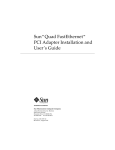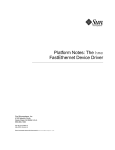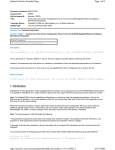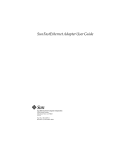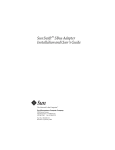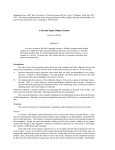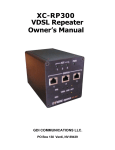Download Sun Microsystems Ethernet Device Driver none User's Manual
Transcript
Platform Notes: The hme Fast Ethernet Device Driver Sun Microsystems Computer Company 2550 Garcia Avenue Mountain View, CA 94043 USA 415 960-1300 fax 415 969-9131 Part No: 802-5333-10 Revision A, May 1996 Copyright 1996 Sun Microsystems, Inc., 2550 Garcia Avenue, Mountain View, California 94043-1100 U.S.A. All rights reserved. This product or document is protected by copyright and distributed under licenses restricting its use, copying, distribution, and decompilation. No part of this product or document may be reproduced in any form by any means without prior written authorization of Sun and its licensors, if any. Portions of this product may be derived from the UNIX® system, licensed from Novell, Inc., and from the Berkeley 4.3 BSD system, licensed from the University of California. UNIX is a registered trademark in the United States and other countries and is exclusively licensed by X/Open Company Ltd. Third-party software, including font technology in this product, is protected by copyright and licensed from Sun’s suppliers. RESTRICTED RIGHTS LEGEND: Use, duplication, or disclosure by the government is subject to restrictions as set forth in subparagraph (c)(1)(ii) of the Rights in Technical Data and Computer Software clause at DFARS 252.227-7013 and FAR 52.227-19. Sun, Sun Microsystems, the Sun logo, Solaris, NFS, Online Backup, Online: DiskSuite, Solstice DiskSuite, X11/NeWS, JumpStart, Sun-4, SunSwift, SunFastEthernet , Enterprise, and Ultra are trademarks or registered trademarks of Sun Microsystems, Inc. in the United States and other countries. All SPARC trademarks are used under license and are trademarks or registered trademarks of SPARC International, Inc. in the United States and other countries. Products bearing SPARC trademarks are based upon an architecture developed by Sun Microsystems, Inc. The OPEN LOOK® and Sun™ Graphical User Interfaces were developed by Sun Microsystems, Inc. for its users and licensees. Sun acknowledges the pioneering efforts of Xerox in researching and developing the concept of visual or graphical user interfaces for the computer industry. Sun holds a non-exclusive license from Xerox to the Xerox Graphical User Interface, which license also covers Sun’s licensees who implement OPEN LOOK GUIs and otherwise comply with Sun’s written license agreements. X Window System is a trademark of X Consortium, Inc. THIS PUBLICATION IS PROVIDED “AS IS” WITHOUT WARRANTY OF ANY KIND, EITHER EXPRESS OR IMPLIED, INCLUDING, BUT NOT LIMITED TO, THE IMPLIED WARRANTIES OF MERCHANTABILITY, FITNESS FOR A PARTICULAR PURPOSE, OR NON-INFRINGEMENT. Please Recycle Copyright 1996 Sun Microsystems Inc., 2550 Garcia Avenue, Mountain View, Californie 94043-1100, U.S.A.Tous droits réservés. Ce produit ou document est protégé par un copyright et distribué avec des licences qui en restreignent l’utilisation, la copie, la distribution, et la décompilation. Aucune partie de ce produit ou de sa documentation associée ne peut être reproduite sous aucune forme, par quelque moyen que ce soit, sans l’autorisation préalable et écrite de Sun et de ses bailleurs de licence, s’il y en a. Des parties de ce produit pourront être dérivées du système UNIX® licencié par Novell, Inc. et du système Berkeley 4.3 BSD licencié par l’Université de Californie. UNIX est une marque enregistrée aux Etats-Unis et dans d’autres pays et licenciée exclusivement par X/Open Company Ltd. Le logiciel détenu par des tiers, et qui comprend la technologie relative aux polices de caractères, est protégé par un copyright et licencié par des fournisseurs de Sun. Sun, Sun Microsystems, le logo Sun,NFS, Online Backup, Online: DiskSuite, Solstice DiskSuite, X11/NeWS, JumpStart, Sun-4, SunSwift, SunFastEthernet , Enterprise, et Ultra sont des marques déposées ou enregistrées de Sun Microsystems, Inc. aux EtatsUnis et dans d’autres pays. Toutes les marques SPARC, utilisées sous licence, sont des marques déposées ou enregistrées de SPARC International, Inc. aux Etats-Unis et dans d’autres pays. Les produits portant les marques SPARC sont basés sur une architecture développée par Sun Microsystems, Inc. Les interfaces d’utilisation graphique OPEN LOOK® et Sun™ ont été développées par Sun Microsystems, Inc. pour ses utilisateurs et licenciés. Sun reconnaît les efforts de pionniers de Xerox pour la recherche et le développement du concept des interfaces d’utilisation visuelle ou graphique pour l’industrie de l’informatique. Sun détient une licence non exclusive de Xerox sur l’interface d’utilisation graphique Xerox, cette licence couvrant aussi les licenciés de Sun qui mettent en place l’interface d’utilisation graphique OPEN LOOK et qui en outre se conforment aux licences écrites de Sun. Le système X Window est un produit du X Consortium, Inc. CETTE PUBLICATION EST FOURNIE “EN L’ETAT” SANS GARANTIE D’AUCUNE SORTE, NI EXPRESSE NI IMPLICITE, Y COMPRIS, ET SANS QUE CETTE LISTE NE SOIT LIMITATIVE, DES GARANTIES CONCERNANT LA VALEUR MARCHANDE, L’APTITUDE DES PRODUITS A RÉPONDRE A UNE UTILISATION PARTICULIERE, OU LE FAIT QU’ILS NE SOIENT PAS CONTREFAISANTS DE PRODUITS DE TIERS. Contents 1. Introduction to the hme Fast Ethernet Device Driver . . . . . . . 1 Related Documentation. . . . . . . . . . . . . . . . . . . . . . . . . . . . . . . . . 1 Typographic Conventions. . . . . . . . . . . . . . . . . . . . . . . . . . . . . . . 2 Ordering Sun Documents . . . . . . . . . . . . . . . . . . . . . . . . . . . . . . . 3 2. The hme Device Driver. . . . . . . . . . . . . . . . . . . . . . . . . . . . . . . . . 5 Hardware Overview . . . . . . . . . . . . . . . . . . . . . . . . . . . . . . . . . . . 5 Operating Speeds and Modes. . . . . . . . . . . . . . . . . . . . . . . . . . . . 6 Auto-Negotiation . . . . . . . . . . . . . . . . . . . . . . . . . . . . . . . . . . . . . . 6 Internal Transceiver . . . . . . . . . . . . . . . . . . . . . . . . . . . . . . . . . 7 External Transceiver . . . . . . . . . . . . . . . . . . . . . . . . . . . . . . . . 7 3. Parameter Definitions . . . . . . . . . . . . . . . . . . . . . . . . . . . . . . . . . 9 Driver Parameter Values and Definitions . . . . . . . . . . . . . . . . . . 9 Defining the Current Status . . . . . . . . . . . . . . . . . . . . . . . . . . 11 Inter-Packet Gap Parameters . . . . . . . . . . . . . . . . . . . . . . . . . 11 et Using lance_mode and ipg0 Packet Using lance_mode and ipg0. . . . . . . . . . . . . . . 12 v vi Operational Mode Parameters . . . . . . . . . . . . . . . . . . . . . . . . 13 Defining the Number of Back-to-Back Packets To Transmit 15 Reporting Transceiver Capabilities . . . . . . . . . . . . . . . . . . . . 15 Reporting the Link Partner Capabilities . . . . . . . . . . . . . . . . 16 4. Setting Parameters . . . . . . . . . . . . . . . . . . . . . . . . . . . . . . . . . . . . 19 Parameter Options . . . . . . . . . . . . . . . . . . . . . . . . . . . . . . . . . . . . . 19 Setting Parameters Using ndd . . . . . . . . . . . . . . . . . . . . . . . . . . . 20 Identifying Device Instances . . . . . . . . . . . . . . . . . . . . . . . . . 20 ▼ To specify the device instance for the ndd utility 20 Non-Interactive and Interactive Modes . . . . . . . . . . . . . . . . 21 ▼ To modify a parameter value . . . . . . . . . . . . . . . . . 21 ▼ To display the value of a parameter . . . . . . . . . . . 22 ▼ To modify a parameter value in interactive mode 22 ▼ To list all the parameters supported by the hme driver . . . . . . . . . . . . . . . . . . . . . . . . . . . . . . . . . 23 ▼ To select one of the five local transceiver capabilities and set the mode to forced mode . . . 24 ▼ To set the mode to auto-negotiation . . . . . . . . . . . 24 Configuring TCP/IP for Maximum Performance . . . . . . . . 25 ▼ To benchmark the TCP/IP throughput . . . . . . . . . 25 ▼ To set the TCP hiwater marks for best performance . . . . . . . . . . . . . . . . . . . . . . . . . . . . . . . 25 Platform Notes: The hme Fast Ethernet Device Driver—May 1996 Setting Parameters in the /etc/system File . . . . . . . . . . . . . . 25 ▼ To set the ipg1 to 10 and ipg2 to 5 when you reboot . 26 Setting Parameters Using the hme.conf File. . . . . . . . . . . . . . . 27 ▼ To set ipg1 to 20 and ipg2 to 10 for the SUNW,hme device in SBus slot 0xe . . . . . . . . . . . . . . . . . . . . . . . . . . . 27 Contents vii viii Platform Notes: The hme Fast Ethernet Device Driver—May 1996 Introduction to the hme Fast Ethernet Device Driver 1 This book describes how to configure the hme driver for the Sun Ultra 1 Series systems, the Sun Ultra 2 Series system, the Ultra Enterprise 3000, 4000, 5000, and 6000 systems, the SunSwift SBus Adapter, and the SunFastEthernet Adapter 2.0. To configure the hme driver you can use the ndd utility to set the parameters. If you use the ndd utility, the parameter values are effective until you reboot the system. To keep the values in effect even after rebooting the system, enter the parameter values into the /etc/system file or the hme.conf file in the /kernel/drv directory. Chapter 2 describes the hme device driver and includes topics such as operating speeds and modes, auto-negotiation, the internal transceiver, and the external transceiver. Chapter 3 describes the parameters and settings for the hme device driver. Chapter 4 describes how to set the hme device driver parameter values using the ndd utility and also in the /etc/system and hme.conf files. Related Documentation The following related books provide an overview of the hme driver and the FEPS ASIC, give more information on the Ethernet standard, and list man pages for the hme driver. • SMCC SPARC Hardware Platform Guide: Provides an overview of the hme driver and the Fast Ethernet Parallel Port SCSI (FEPS) ASIC • IEEE 802.3u Ethernet Standard: Provides additional information about the Ethernet standard 1 1 • Solaris Reference Manual for SMCC-Specific Software: Explains the following man pages: • ndd (1M) man page summarizes information on how to use the ndd utility • prtconf (1M), system (4), and driver.conf (4) man pages describe information about entering parameter values into the /etc/system file and the hme.conf file Typographic Conventions Table 1-1 describes the typographic conventions used in this book. Table 1-1 Typographic Conventions Typeface or Symbol 2 Meaning Example AaBbCc123 The names of commands, files, and directories; on-screen computer output Edit your .login file. Use ls -a to list all files. machine_name% You have mail. AaBbCc123 What you type, contrasted with on-screen computer output AaBbCc123 Command-line placeholder: replace with a real name or value To delete a file, type rm filename. AaBbCc123 Book titles, new words or terms, or words to be emphasized Read Chapter 6 in the User’s Guide. These are called class options. You must be root to do this. machine_name% su Password: Platform Notes: The hme Fast Ethernet Device Driver—May 1996 1 Shell Prompts in Command Examples Table 1-2 shows the default system prompt and superuser prompt for the C shell, Bourne shell, and Korn shell. Table 1-2 Shell Prompts Shell Prompt C shell machine_name% C shell superuser machine_name# Bourne shell and Korn shell $ Bourne shell and Korn shell superuser # Ordering Sun Documents The SunDocs Order Desk is a distribution center for Sun Microsystems technical documentation. You can use major credit cards and company purchase orders. You can order documentation in the following ways (see Table 1-3): Table 1-3 How to Order Sun Documents Country Telephone Fax United States 1-800-873-7869 1-800-944-0661 United Kingdom 0-800-89-88-88 0-800-89-88-87 France 05-90-61-57 05-90-61-58 Belgium 02-720-09-09 02-725-88-50 Luxembourg 32-2-720-09-09 32-2-725-88-50 Germany 01-30-81-61-91 01-30-81-61-92 The Netherlands 06-022-34-45 06-022-34-46 Sweden 020-79-57-26 020-79-57-27 Switzerland 155-19-26 155-19-27 Japan 0120-33-9096 0120-33-9097 World Wide Web: http://www.sun.com/sunexpress/ Introduction to the hme Fast Ethernet Device Driver 3 1 Sun Welcomes Your Comments Please use the Reader Comment Card that accompanies this document. We are interested in improving our documentation and welcome your comments and suggestions. If a card is not available, you can also email or fax your comments to us. Please include the part number of your document in the subject line of your email or fax message. • • 4 Email: [email protected] Fax: SMCC Document Feedback 1-415-786-6443 Platform Notes: The hme Fast Ethernet Device Driver—May 1996 The hme Device Driver 2 The hme device driver handles the SUNW,hme device on these hardware devices: • • • • • SunSwift SBus Adapter SunFastEthernet Adapter 2.0 Sun Ultra 1 Creator Series systems Sun Ultra 2 Series system Ultra Enterprise 3000, 4000, 5000, and 6000 systems This chapter gives a hardware overview of the SUNW,hme device, provides information on the operating speeds and modes for the SUNW,hme device, and discusses auto-negotiation, the internal transceiver, and the external transceiver for the hme device driver. Note that the external transceiver is not present on the SunSwift SBus Adapter. Hardware Overview The SUNW,hme device provides 10BASE-TX or 100BASE-T networking interfaces using the Fast Ethernet Parallel Port SCSI (FEPS) ASIC and an internal transceiver. The driver automatically sets the link speed to 10 or 100 Mbps and conforms to the 100BASE-T IEEE 802.3u Ethernet standard. The FEPS ASIC provides the SBus interface and Media Access Control (MAC) functions. The internal transceiver, which connects to an RJ-45 connector on all of the above hardware devices, provides the physical layer functions. 5 2 In addition to the RJ-45 connector, a Media Independent Interface (MII) connector, which is an Ultra DB 40 connector, is also provided on Sun systems. The MII connects to an external transceiver that may use any physical media, such as copper or fiber as specified in the 100BASE-TX standard. When an external transceiver is connected to the MII, the driver selects the external transceiver and disables the internal transceiver. The external transceiver may also support the 100BASE-T4 standard, which allows the link to operate in 100 Mbps speed using four pairs of category 3 or better cable. Operating Speeds and Modes You can operate the link in any of the following speeds and modes with the SUNW, hme device: • • • • • 100 BASE-T4 (with external transceiver only) 100 Mbps, full-duplex 100 Mbps, half-duplex 10 Mbps, full-duplex 10 Mbps, half-duplex Note – An industry standard for full-duplex operation does not currently exist. Use the full-duplex mode only when two SUNW, hme devices are connected back-to-back. The 100BASE-T standard, IEEE 802.3u Ethernet Standard, describes these speeds and modes. Auto-Negotiation The auto-negotiation protocol, as specified by the 100BASE-T standard, selects the operation mode (half-duplex or full-duplex) at boot time or when the link state changes (the link goes down or tried to come up). The hme driver operates the SUNW, hme device in half-duplex mode only by default. The autonegotiation protocol also selects the speed. The auto-negotiation protocol does the following: • • 6 Identifies all link partner-supported modes of operation Advertises its capabilities to the link partner Platform Notes: The hme Fast Ethernet Device Driver—May 1996 2 • Selects the highest common denominator mode of operation based on the following priorities: • 100 BASE-T4 • 100 Mbps, full-duplex • 100 Mbps, half-duplex • 10 Mbps, full-duplex • 10 Mbps, half-duplex The link partner is the networking device (system, Ethernet hub, or Ethernet switch) at the other end of the link or cable. If the SUNW,hme device is connected to a remote system or interface that is not capable of autonegotiation, the system automatically selects the correct speed and half-duplex mode. If adapters or systems are connected to a link partner and the auto-negotiation protocol fails to operate successfully, you can configure the device so it does not use this protocol. This forces the driver to set up the link in the mode and speed that you choose instead of using the auto-negotiation protocol. Internal Transceiver The internal transceiver is a feature supported by the driver and is capable of all the operating speeds and modes (except the 100BASE-T4 mode) listed in the section “Operating Speeds and Modes” on page 6. When the internal transceiver is used, the default is auto-negotation by the hme driver, which automatically selects the speed and mode of the link. The internal transceiver performs auto-negotiation with the remote end of the link (link partner) to select a common mode of operation. The internal transceiver also supports a forced mode of operation. This is where the user selects the speed and mode using the ndd utility, the /etc/system file, or the hme.conf file. The ndd utility makes calls to the hme driver to choose the speed and mode. External Transceiver When an external transceiver (not present on the SunSwift SBus Adapter) is connected to the MII interface, the driver selects the external transceiver for networking operations. The hme Device Driver 7 2 • If the external transceiver supports auto-negotiation, the driver uses the auto-negotiation feature to select the link speed and mode. • If the external transceiver does not support auto-negotiation, the driver selects the highest priority mode supported by the transceiver. You can also manually select the speed and mode of the link. For example, two transceivers might not support the same mode and speed. Therefore, you must select the highest mode and speed that both transceivers support using the ndd utility. See the list of operating speeds and modes in the section, “Operating Speeds and Modes” on page 6. 8 Platform Notes: The hme Fast Ethernet Device Driver—May 1996 3 Parameter Definitions This chapter describes the parameters and settings for the hme device driver. Driver Parameter Values and Definitions The following sections describe the hme driver parameters, which are listed in Table 3-1. Table 3-1 hme Driver Parameter, Status, and Descriptions Parameter Status Description transceiver_inuse Read only Defines the current status link_status Read only Defines the current status link_speed Read only Defines the current status link_mode Read only Defines the current status ipg1 Read and write Inter-packet gap parameter ipg2 Read and write Inter-packet gap parameter use_int_xcvr Read and write Operational mode parameter pace_size Read and write Operational mode parameter adv_autoneg_cap Read and write Operational mode parameter adv_100T4_cap Read and write Operational mode parameter adv_100fdx_cap Read and write Operational mode parameter 9 3 Table 3-1 10 hme Driver Parameter, Status, and Descriptions (Continued) Parameter Status Description adv_100hdx_cap Read and write Operational mode parameter adv_10fdx_cap Read and write Operational mode parameter adv_10hdx_cap Read and write Operational mode parameter autoneg_cap Read only Local transceiver auto negotiation capability 100T4_cap Read only Local transceiver capability of the hardware 100fdx_cap Read only Local transceiver capability of the hardware 100hdx_cap Read only Local transceiver capability of the hardware 10fdx_cap Read only Local transceiver capability of the hardware 10hdx_cap Read only Local transceiver capability of the hardware lp_autoneg_cap Read only Link partner auto negotiation capability lp_100T4_cap Read only Link partner capability lp_100fdx_cap Read only Link partner capability lp_100hdx_cap Read only Link partner capability lp_10fdx_cap Read only Link partner capability lp_10hdx_cap Read only Link partner capability instance Read and write Device instance lance_mode Read and write Additional delay before transmitting a packet ipg0 Read and write Additional delay before transmitting a packet Platform Notes: The hme Fast Ethernet Device Driver—May 1996 3 Defining the Current Status The read-only parameters described in Table 3-2 explain the operational mode of the interface. These parameters define the current status. Table 3-2 Read-Only Parameters Defining the Current Status Parameter Values Description transceiver_inuse 0 1 = Internal transceiver = External transceiver 0 1 Current link status = Link down = Link up 0 1 Valid only if the link is up = 10 Mbps = 100 Mbps 0 1 Valid only if the link is up = Half duplex = Full duplex link_status link_speed link_mode Inter-Packet Gap Parameters The Fast Ethernet Parallel Port SCSI (FEPS) ASIC supports programmable Inter-Packet Gap (IPG) parameters ipg1 and ipg2. The total IPG is the sum of ipg1 and ipg2. The total IPG is 9.6 microseconds when the link speed set by the auto-negotiation protocol is 10 Mbps. When the link speed is 100 Mbps, the total IPG is 0.96 microseconds. Table 3-3 lists the default values and allowable values for the inter-packet gap (IPG) parameters, ipg1 and ipg2. Table 3-3 Read-Write Inter-Packet Gap Parameter Values and Descriptions Parameter Values (Byte-time) Description ipg1 0, 255 ipg1 = 8 (default at initialization) ipg2 0, 255 ipg2 = 4 (default at initialization) Parameter Definitions 11 3 By default, the driver sets ipg1 to 8-byte time and ipg2 to 4-byte time, which are the standard values. (Byte time is the time it takes to transmit one byte on the link, with a link speed of either 100 Mbps or 10 Mbps.) If your network has systems that use longer IPG (the sum of ipg1 and ipg2) and if those machines seem to be slow in accessing the network, increase the values of ipg1 and ipg2 to match the longer IPGs of other machines. Defining an Additional Delay Before Transmitting a Packet Using lance_mode and ipg0 The Fast Ethernet Parallel Port SCSI (FEPS) ASIC supports a programmable mode called lance_mode. The ipg0 parameter is associated with lance_mode. After a packet is received with lance_mode enabled (default) an additional delay is added by setting the ipg0 parameter before transmitting the packet. This delay, set by the ipg0 parameter, is in addition to the delay set by the ipg1 and ipg2 parameters. The additional delay set by ipg0 helps to reduce collisions. Systems that have lance_mode enabled might not have enough time on the network. If lance_mode is disabled, the value of ipg0 is ignored and no additional delay is set. Only the delays set by ipg1 and ipg2 are used. Disable lance_mode if other systems keep sending a large number of back-to-back packets. You can set the additional delay with the ipg0 parameter from 0 to 31, which is the nibble time delay. Note that nibble time is the time it takes to transfer four bits on the link. If the link speed is 10 Mbps, nibble time is equal to 400 ns. If the link speed is 100 Mbps, nibble time is equal to 40 ns. For example, if the link speed is 10 Mbps, and you set ipg0 to 20 nibble times, multiply 20 by 400 ns to get 800 ns. If the link speed is 100 Mbps, and you set ipg0 to 30 nibble-times, multiply 30 by 40 ns to get 120 ns. 12 Platform Notes: The hme Fast Ethernet Device Driver—May 1996 3 Table 3-4 defines the lance_mode and ipg0 parameters. Table 3-4 Parameters Defining lance_mode and ipg0 Parameter Values Description lance_mode 0 1 lance_mode disabled lance_mode enabled (default) ipg0 0-311 Additional IPG before transmitting a packet (after receiving a packet) 1. The default value is 16 nibble-times, which is 6.4 microseconds for 10 Mbps and 0.64 microseconds for 100 Mbps. Operational Mode Parameters Table 3-5 describes the operational mode parameters and their default values. Table 3-5 Parameter Operational Mode Parameters Values Description 0 1 Local transceiver capability advertised by the hardware = Forced mode = Auto-negotiation (default) 0 1 Local transceiver capability advertised by the hardware; read/write parameter = Not 100BASE-T4 capable = 100BASE-T4 capable 0 1 Local transceiver capability advertised by the hardware; read/write parameter = Not 100Mbit/sec full-duplex capable (default) = 100Mbit/sec full-duplex capable 0 1 Local transceiver capability advertised by the hardware; read/write parameter = Not 100Mbit/sec half-duplex capable = 100Mbit/sec half-duplex capable (default) adv_autoneg_cap adv_100T4_cap1 adv_100fdx_cap1 adv_100hdx_cap1 Parameter Definitions 13 3 Table 3-5 Parameter Operational Mode Parameters (Continued) Values Description 0 1 Local transceiver capability advertised by the hardware; read/write parameter = Not 10Mbit/sec full-duplex capable (default) = 10Mbit/sec full-duplex capable 0 1 Local transceiver capability advertised by the hardware; read/write parameter = Not 10Mbit/sec half-duplex capable = 10Mbit/sec half-duplex capable (default) 0 1 Local transceiver capability selected for networking by the user = External transceiver is used if connected (default) = Internal transceiver is used, even if the external transceiver is connected adv_10fdx_cap1 adv_10hdx_cap1 use_int_xcvr 1. The priority (in descending order) for these parameters is: adv_100T4_cap, adv_100fdx_cap, adv_100hdx_cap, adv_10fdx_cap, adv_10hdx_cap Selecting the Internal or External Transceiver Use the use_int_xcvr parameter to change the default behavior. For example, you can select the internal transceiver, even though the driver is capable of selecting the external transceiver. The driver, not the hardware, makes the selection between the internal and external transceiver. If the external transceiver, which is connected to the MII interface, is present, the driver selects the external transceiver using the default use_int_xcvr 0. If the external transceiver is not present, the driver selects the internal transceiver. When this parameter is set to use_int_xcvr 1, the driver selects the internal transceiver, even if the external transceiver is connected. 14 Platform Notes: The hme Fast Ethernet Device Driver—May 1996 3 Defining the Number of Back-to-Back Packets To Transmit The pace_size parameter (see Table 3-6) defines the maximum number of back-to-back packets you can transmit at one time. If the value is zero, there is no limit to the number of back-to-back packets that can be transmitted. Table 3-6 Back-to-back Packet Transmission Capability Parameter Values Description pace_size 1 to 255 = Number of back-to-back packets transmitted at one time 0 = No limit to the number of back-to-back packets that can be transmitted (default) Reporting Transceiver Capabilities Table 3-7 describes the read-only transceiver capabilities (either the internal transceiver or the external transceiver), whichever is selected. Table 3-7 Read-Only Transceiver Capabilities Parameter Values Description 0 1 Local transceiver capability of the hardware = Not capable of auto-negotiation = Auto negotiation capable 0 1 Local external transceiver capability of the hardware = Not 100BASE-T4 capable = 100BASE-T4 capable 0 1 Local transceiver capability of the hardware; initialized at startup = Not 100Mbit/sec full-duplex capable = 100Mbit/sec full-duplex capable autoneg_cap 100T4_cap 100fdx_cap Parameter Definitions 15 3 Table 3-7 Read-Only Transceiver Capabilities Parameter Values Description 0 1 Local transceiver capability of the hardware; initialized at startup = Not 100Mbit/sec half-duplex capable = 100Mbit/sec half-duplex capable 0 1 Local transceiver capability of the hardware; initialized at startup = Not 10Mbit/sec full-duplex capable = 10Mbit/sec full-duplex capable 0 1 Local transceiver capability of the hardware; initialized at startup = Not 10Mbit/sec half-duplex capable = 10Mbit/sec half-duplex capable 100hdx_cap 10fdx_cap 10hdx_cap The parameters in Table 3-7 define the capabilities of the hardware. The internal transceiver can support all of these capabilities. The capabilities of the external transceiver are dependent on the device. If the external transceiver is not capable of auto-negotiation but has the capability of all speeds and modes (100 Mbps, 10 Mbps, half-duplex, and full-duplex), you must determine the capabilities of the external transceiver. Reporting the Link Partner Capabilities Table 3-8 describes the read-only link partner capabilities. Table 3-8 16 Read-Only Link Partner Capabilities Parameter Values Description lp_autoneg_cap 0 1 = No auto-negotiation = Auto-negotiation lp_100T4_cap 0 1 = No 100BASE-T4 = 100BASE-T4 lp_100fdx_cap 0 1 = No100Mbit/sec full-duplex transmission = 100Mbit/sec full-duplex Platform Notes: The hme Fast Ethernet Device Driver—May 1996 3 Table 3-8 Read-Only Link Partner Capabilities (Continued) Parameter Values Description lp_100hdx_cap 0 1 = No 100Mbit/sec half-duplex transmission = 100Mbit/sec half-duplex lp_10fdx_cap 0 1 = No 10Mbit/sec full-duplex transmission = 10Mbit/sec full-duplex lp_10hdx_cap 0 1 = No 10Mbit/sec half-duplex transmission = 10Mbit/sec half-duplex If the link partner is not capable of auto-negotiation (when lp_autoneg_cap is 0) the information described in Table 3-8 is not relevant and the parameter value=0. If the link partner is capable of auto-negotation (when lp_autoneg_cap is 1) then the speed and mode information is displayed when you use auto-negotiation and get the link partner capabilities. Parameter Definitions 17 3 18 Platform Notes: The hme Fast Ethernet Device Driver—May 1996 Setting Parameters 4 This chapter describes how to configure the hme driver parameters using the ndd utility in the /etc/system file, or in the hme.conf file. Use the ndd utility to configure parameters that are valid until you reboot the system. To configure the hme driver parameters for all devices in the system so that the parameter values are always in effect (even after rebooting the system), enter the parameter values in the /etc/system file. When the system is rebooted, it reads the /etc/system file and sets the parameter values in that file. To set a particular parameter for a device in the system, set the parameter in the hme.conf file in the /kernel/drv directory. The parameters set in the hme.conf file have precedence over the parameters set in the /etc/system file and override the parameters set in the /etc/system file. Setting hme.conf parameter values are always in effect (even after rebooting the system). Parameter Options You can set the hme device driver parameters in three ways (ndd, /etc/system, and hme.conf), depending on your needs. To set parameters that are valid until you reboot the system, use the ndd utility. Using ndd is a good way to test parameter settings. 19 4 To set parameters so they remain in effect after you reboot the system: • Add the parameter values to /etc/system when you want to configure parameters for all devices in the system. • Create the hme.conf file and add parameter values to hme.conf when you need to set a particular parameter for a device in the system. If you want to test parameter settings, use the ndd utility described in Chapter 3. With ndd, the parameters are effective until you reboot the system. To make the parameter settings permanent, enter the values in /etc/system or hme.conf as described in this chapter. Setting Parameters Using ndd Use the ndd utility to configure parameters that are valid until you reboot the system. The ndd utility supports any networking driver, which implements the Data Link Provider Interface (DLPI). The following sections describe how you can use the hme driver and the ndd utility to modify (with the -set option) or display (without the -set option) the parameters for each SUNW,hme device. Identifying Device Instances Before you use the ndd utility to get or set a parameter for the hme device, you must specify the device instance for the utility if there is more than one SUNW,hme device. Note – If there is only one SUNW,hme device, the device is automatically chosen by the ndd utility. ▼ To specify the device instance for the ndd utility 1. Check the /etc/path_to_inst file to identify the instance associated with a particular device. 20 Platform Notes: The hme Fast Ethernet Device Driver—May 1996 4 2. Use that instance number to select the device as follows: % ndd -set /dev/hme instance <instance#> The device remains selected until you change the selection. Non-Interactive and Interactive Modes You can use the ndd utility in two modes: • • Non-interactive Interactive In non-interactive mode, you invoke the utility to execute a specific command. Once the command is executed, you exit the utility. In interactive mode, you can use the utility to get or set more than one parameter value. (Refer to the ndd (1M) man page for more information.) Using the ndd Utility in Non-Interactive Mode This section describes how to modify a parameter value and how to display a parameter value. ▼ To modify a parameter value ♦ Use the -set option. If you invoke the ndd utility with the -set option, the utility passes value, which must be specified down to the named /dev/hme driver instance, and assigns it to the parameter: % ndd -set /dev/hme parameter value Setting Parameters 21 4 ▼ To display the value of a parameter ♦ Specify the parameter name (and omit the value). When you omit the -set option, a query operation is assumed and the utility queries the named driver instance, retrieves the value associated with the specified parameter, and prints it: % ndd /dev/hme parameter Using the ndd Utility in Interactive Mode ▼ To modify a parameter value in interactive mode ♦ Specify ndd hme, as shown below. The ndd utility then prompts you for the name of the parameter: % ndd /dev/hme name to get/set? (Enter the parameter name or ? to view all parameters) After entering the parameter name, the ndd utility prompts you for the parameter value (see Tables 3-1 through 3-8). 22 Platform Notes: The hme Fast Ethernet Device Driver—May 1996 4 ▼ To list all the parameters supported by the hme driver ♦ Type ndd /dev/hme \?. (Refer to Table 3-1 through 3-8 for parameter descriptions. ) example# ndd /dev/hme \? ? transceiver_inuse link_status link_speed link_mode ipg1 ipg2 use_int_xcvr pace_size adv_autoneg_cap adv_100T4_cap adv_100fdx_cap adv_100hdx_cap adv_10fdx_cap adv_10hdx_cap autoneg_cap 100T4_cap 100fdx_cap 100hdx_cap 10fdx_cap 10hdx_cap lp_autoneg_cap lp_100T4_cap lp_100fdx_cap lp_100hdx_cap lp_10fdx_cap lp_10hdx_cap instance lance_mode ipg0 example# Setting Parameters (read (read (read (read (read (read (read (read (read (read (read (read (read (read (read (read (read (read (read (read (read (read (read (read (read (read (read (read (read (read only) only) only) only) only) and write) and write) and write) and write) and write) and write) and write) and write) and write) and write) only) only) only) only) only) only) only) only) only) only) only) only) and write) and write) and write) 23 4 Setting Forced Mode This section describes how to set forced mode (not capable of autonegotiation). ▼ To select one of the five local transceiver capabilities and set the mode to forced mode 1. Select one of the following capabilities: adv_100T4_cap, adv_100fdx_cap, adv_100hdx_cap, adv_10fdx_cap, or adv_10hdx_cap, and set its value to 1. If you select more than one of the local transceiver capabilities, the driver selects the one that is highest in the priority order (see the footnote from Table 3-5 on page 13). 2. Set the local transceiver capabilities advertised by the hardware to forced mode = 0, which is not capable of auto-negotiation: adv_autoneg_cap 0 Use the ndd utility as described in “Using the ndd Utility in Interactive Mode” on page 22. Auto-Negotiation Mode This section describes how to select at least one of the five local transceiver capabilities and set the mode to auto-negotiation. ▼ To set the mode to auto-negotiation 1. Select at least one of the five capabilities (adv_100T4_cap, adv_100fdx_cap, adv_100hdx_cap, adv_10fdx_cap, adv_10hdx_cap) that you want to advertise to the remote system, and set its value to 1. 2. Set the local transceiver capabilities advertised by the hardware to 1, the auto-negotiation setting: adv_autoneg_cap 1 Use the ndd utility as described in “Using the ndd Utility in Interactive Mode” on page 22. 24 Platform Notes: The hme Fast Ethernet Device Driver—May 1996 4 Configuring TCP/IP for Maximum Performance This section describes how to benchmark the TCP/IP throughput and how to set the TCP/IP hiwater marks for best performance. ▼ To benchmark the TCP/IP throughput ♦ Use the ndd command to configure the values of some of the TCP parameters for maximum performance. ▼ To set the TCP hiwater marks for best performance ♦ Type the following ndd commands: # ndd -set /dev/tcp tcp_xmit_hiwat 65535 # ndd -set /dev/tcp tcp_recv_hiwat 65535 # ndd -set /dev/tcp tcp_cwnd_max 65534 Setting Parameters in the /etc/system File To configure the hme driver parameters for all SUNW,hme devices in the system so that the parameter variables are always effective (even after rebooting the system), enter the parameter variables in the /etc/system file. When you reboot the system, the system reads the /etc/system file and sets these parameter variables in the hme module in the operating system kernel. Table 4-1 lists the variables you need to set in the /etc/system file. Table 4-1 Setting Variables in the /etc/system File Parameter Variable ipg1 hme_ipg1 ipg2 hme_ipg2 use_int_xcvr hme_use_int_xcvr pace_size hme_pace_size adv_autoneg_cap hme_adv_autoneg_cap Setting Parameters 25 4 Table 4-1 Setting Variables in the /etc/system File (Continued) Parameter Variable adv_100T4_cap hme_adv_100T4_cap adv_100fdx_cap hme_adv_100fdx_cap adv_100hdx_cap hme_adv_100hdx_cap adv_10fdx_cap hme_adv_10fdx_cap adv_10hdx_cap hme_adv_10hdx_cap lance_mode hme_lance_mode ipg0 hme_ipg0 These parameter values, described in Chapter 3, are applicable to all SUNW,hme devices on the system. Refer to Table 3-2 on page 11 through Table 3-8 on page 16 for parameter descriptions. For example: ▼ To set the ipg1 to 10 and ipg2 to 5 when you reboot 1. Become superuser. 2. Add the following lines to the /etc/system file: set hme:hme_ipg1 = 10 set hme:hme_ipg2 = 5 3. Save the /etc/system file. 4. Save all files and exit all programs. Exit the windowing system. 5. Reboot the system by typing init 6 at the # prompt. The system is halted and then rebooted. 26 Platform Notes: The hme Fast Ethernet Device Driver—May 1996 4 Setting Parameters Using the hme.conf File You can also specify the properties described in the section “Setting Parameters in the /etc/system File” on page 25 on a per device basis by creating the hme.conf file in the /kernel/drv directory. The properties set in the hme.conf file will override the parameters set in the /etc/system file. Use hme.conf when you need to set a particular parameter for a device in the system. The parameters you set are read and write parameters that are listed in Chapter 3. The man pages for prtconf (1M), system (4) and driver.conf (4) include additional details. For example: ▼ To set ipg1 to 20 and ipg2 to 10 for the SUNW,hme device in SBus slot 0xe 1. Invoke the prtconf -v command and pipe the output to the more command ( prtconf -v | more ) or redirect the output of the command to a file name ( prtconf -v > filename) and print the redirected file. 2. Find the section in the prtconf -v output for SUNW,hme,instance #0, or SUNW,hme,instance #1, and so on. The output for SUNW,hme,instance #0 for a Sun Ultra 1 Creator Series system follows: SUNW,hme, instance #0 Driver software properties: name <pm_norm_pwr> length <4> value <0x00000001>. name <pm_timestamp> length <4> value <0x30743b26>. Register Specifications: Bus Type=0xe, Address=0x8c00000, Bus Type=0xe, Address=0x8c02000, Bus Type=0xe, Address=0x8c04000, Bus Type=0xe, Address=0x8c06000, Bus Type=0xe, Address=0x8c07000, Size=108 Size=2000 Size=2000 Size=2000 Size=20 3. Become superuser. Setting Parameters 27 4 4. Create the hme.conf file in the /kernel/drv directory using a text editor and add lines similar to the following to the file: • Specify name=”hme” and class=”sbus.” • Use the reg property to specify the device, 0xe in this case. Use the value following Bus Type in the prtconf -v output. • Type the addresses followed by the specified sizes. Precede each size with 0x and leading zeros, as indicated in the following screen. • Set ipg1 and ipg2. These parameters are set to 20 and 10, respectively, in this example. Type a semicolon ( ; ) after the last value. The ipg parameters are defined in Chapter 3. name=”hme” class=”sbus” reg=0xe,0x8c00000,0x00000108,0xe,0x8c02000,0x00002000,0xe, 0x8c04000,0x00002000,0xe,0x8c06000,0x00002000,0xe,0x8c07000, 0x00000020 ipg1=20 ipg2=10; 5. Save the hme.conf file. 6. Save and close all files and exit all programs; exit the windowing system. 7. Reboot the system by typing the init 6 command at the # prompt. 28 Platform Notes: The hme Fast Ethernet Device Driver—May 1996






































